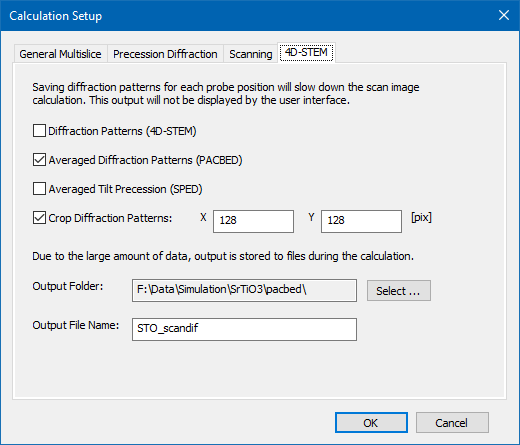|
|
GUI - 4D-STEM Settings > Dr. Probe / Documentation / GUI / Calculation / Setup |

|
These settings enable the output of diffraction patterns for each probe position (4D-STEM) of a scan image simulation. Whilst scanning diffraction patterns will be saved to files (one for each probe position) and these results cannot be reviewed by the user interface.

Output of diffraction patterns for each probe position (4D-STEM) and of position averaged diffraction (PACBED) patterns can be activated by checking the respective checkboxes in this dialog.
If scanning precession electron diffraction (SPED) is activated, the diffraction pattern for each probe position is also averaged while precessing the incident probe tilt. This usually causes very long calculation times. The parameters from the precession diffraction tab will be used.
Diffraction patterns can be cropped to smaller size on output than that used for sampling slice transmission functions in order to save memory on disk.
Select the folder and set a file name to be used for saving the diffraction patterns. The patterns will be stored as binary data files using 32-bit floating point values for intensity. Each file contains one or more diffraction patterns. If simulation of images for multiple thicknesses is used, the files will be respective thickness series of diffraction patterns. For example, if cropping is used to 128 x 128 pixels, and output is made for every 4 slices of a sample with a total thickness corresponding to 64 slices, then the files contain 17 x 128 x 128 values with diffraction patterns of size 128 x 128 pixels stored in sequence beginning with zero thickness.
In case of patterns stored for each probe position a suffix "_YYYY_XXXX.dat" is appended to the file name, where YYYY is the index of the scan row and XXXX is the index of the scan column. PACBED pattern files will be saved with suffix "_avg.dat" appended to the file name.
If any of the two output options (4D-STEM, PACBED) are checked and files are saved to disk, an accompanying JSON file will be saved as well, which holds meta-data describing the results.
Last update: April 14, 2022 contact disclaimer(de)